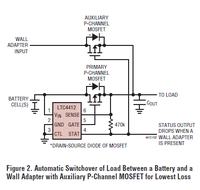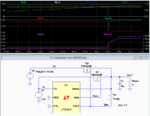tiwari.sachin
Full Member level 6

I am using LTC4412 for power path switching
I have auxillary input (DC Jack) - 9V
Battery: 2 Cell Li Ion
In the example, it shows use of P Channel with Drain connected to Positive and Source to load.
I understand that this would avoid reverse flow but shouldnt the voltage input be connected to Source of MOSFET
I am trying the following Circuit

Mosfet: FDS4935BZ
Load current: Max 3 amps
Results:
When only Battery Connected (eg 7.4, SAY BV): Output is 7.4V
Battery removed from the circuit and When Auxillary Power Connected (9V SAY AV): Output is 9V
When Battery is present and I connect Auxillary Power,
Out is 9V (As expected)
But the battery voltage also shifts to 9V (which should not be the case)
BV Present, AV Absent: Output is BV
BV Absent, AV Present: Output is AV
BV Present, AV Present: Output is AV but BV increases to 9V which shouldnt be the case
BV Present, AV Present
I tried reducing AV, the voltage at the battery stays at AV as long as AV == BV, after that BV stays at 7.4V and output is also 7.4V
I hope I am able to make things clear
- - - Updated - - -
Any other option for power path management should also be ok, provided there is no drop at output, especially from battery, hence using diode oring is not and option
I have auxillary input (DC Jack) - 9V
Battery: 2 Cell Li Ion
In the example, it shows use of P Channel with Drain connected to Positive and Source to load.
I understand that this would avoid reverse flow but shouldnt the voltage input be connected to Source of MOSFET
I am trying the following Circuit

Mosfet: FDS4935BZ
Load current: Max 3 amps
Results:
When only Battery Connected (eg 7.4, SAY BV): Output is 7.4V
Battery removed from the circuit and When Auxillary Power Connected (9V SAY AV): Output is 9V
When Battery is present and I connect Auxillary Power,
Out is 9V (As expected)
But the battery voltage also shifts to 9V (which should not be the case)
BV Present, AV Absent: Output is BV
BV Absent, AV Present: Output is AV
BV Present, AV Present: Output is AV but BV increases to 9V which shouldnt be the case
BV Present, AV Present
I tried reducing AV, the voltage at the battery stays at AV as long as AV == BV, after that BV stays at 7.4V and output is also 7.4V
I hope I am able to make things clear
- - - Updated - - -
Any other option for power path management should also be ok, provided there is no drop at output, especially from battery, hence using diode oring is not and option
Last edited:




